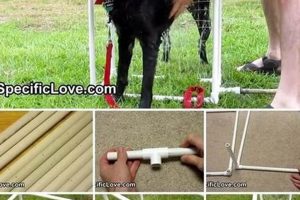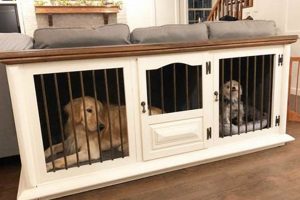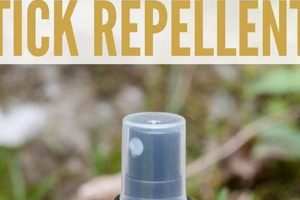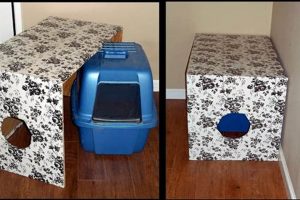The practice of creating a home-based canine bathing setup, often referred to as a do-it-yourself dog cleaning station, involves assembling necessary equipment and products within a residential setting to cleanse a pet dog. This approach offers an alternative to professional grooming services or using public facilities.
Establishing a personal dog washing area can provide several advantages, including cost savings, convenience, and the ability to use specific products tailored to the animal’s needs. Historically, pet owners relied on basic methods for animal hygiene; however, increased awareness of pet health and hygiene has led to more sophisticated and accessible home-based solutions.
The following sections will delve into essential considerations for constructing an effective home dog washing station, covering aspects such as location selection, required tools, appropriate cleaning agents, and safety protocols to ensure a positive and secure bathing experience for both the owner and the dog.
Dog Washing
The following recommendations provide practical advice for effectively and safely managing canine hygiene at home. Adherence to these guidelines promotes a positive experience and optimal results.
Tip 1: Location Selection: Prioritize a space that is easily cleanable and provides adequate drainage. A designated area within a garage, laundry room, or even an outdoor space during suitable weather offers practicality.
Tip 2: Temperature Regulation: Maintain a consistent water temperature, avoiding extremes of hot or cold. Lukewarm water is generally well-tolerated and effective for cleansing.
Tip 3: Shampoo Selection: Employ shampoos specifically formulated for canine use. Human shampoos can disrupt the dog’s skin pH balance, potentially leading to irritation or dryness.
Tip 4: Restraint Techniques: Implement appropriate restraint methods, particularly for anxious or energetic dogs. A leash or strategically placed treats can assist in maintaining composure.
Tip 5: Rinsing Thoroughness: Ensure complete removal of shampoo residue. Inadequate rinsing can lead to skin irritation and discomfort.
Tip 6: Drying Methods: Utilize absorbent towels or a low-velocity, cool-air dryer. Avoid high heat, which can cause skin damage.
Tip 7: Ear Care: Exercise caution to prevent water from entering the ear canals. Use cotton balls to gently clean the outer ear, if necessary.
Tip 8: Post-Bath Reward: Offer positive reinforcement, such as treats or praise, to create a positive association with the bathing process.
Implementing these techniques not only enhances the efficacy of the cleaning process but also contributes to the animal’s overall well-being and acceptance of routine hygiene practices.
The subsequent section will address common challenges encountered during home-based dog washing and offer solutions to mitigate potential difficulties.
1. Location Suitability
Location suitability directly influences the efficacy and convenience of a do-it-yourself dog wash. The chosen space determines the ease with which the bathing process can be executed and the subsequent cleanup managed. For example, an outdoor area provides ample space and natural drainage but is subject to weather conditions, limiting its usability. Conversely, an indoor location, such as a utility room, offers climate control but necessitates adequate drainage to prevent water damage. Inadequate location selection can result in complications ranging from inefficient drainage and difficult cleanup to potential property damage, directly impeding the success of the dog washing endeavor.
Consider the practical significance of location suitability within the context of a limited-space apartment versus a larger house with a dedicated laundry room. In the apartment, a bathtub with appropriate non-slip mats and a handheld showerhead may suffice, but requires meticulous post-bath cleaning to avoid water damage and residue. In a larger house, a dedicated dog washing station with a raised tub and specialized drainage systems offers greater convenience and efficiency. These examples illustrate how location characteristics directly impact the planning and execution of the cleaning activity, including required accessories and management of waste and water.
In conclusion, the link between location suitability and the effectiveness of a do-it-yourself dog wash is undeniable. Selecting an appropriate space based on factors such as drainage, ease of cleaning, and climate control is paramount. Overlooking these considerations can lead to avoidable challenges, compromising the overall effectiveness and potentially creating more work than necessary. Prioritizing location suitability will invariably yield a more efficient and less stressful washing experience.
2. Essential Equipment
Successful execution of a home-based canine bathing regime hinges upon the availability and appropriate utilization of specialized equipment. The selection of tools directly impacts the efficiency, safety, and overall outcome of the “dog wash diy” process.
- Canine-Specific Shampoo
Formulated with a pH balance appropriate for canine skin, this shampoo avoids the irritation and dryness often caused by human-grade alternatives. The selection should consider the dog’s coat type and any specific skin conditions, such as allergies or sensitivities. Using a non-specific shampoo can lead to dermatological issues, undermining the purpose of the wash.
- Handheld Showerhead or Hose Attachment
Providing controlled water flow, this facilitates thorough rinsing of shampoo residue from the dog’s coat. A handheld design allows for targeted application, particularly in hard-to-reach areas. Insufficient rinsing can result in skin irritation and matting of the fur, negating the benefits of the shampoo.
- Non-Slip Mat or Surface
Ensuring stability during the washing process, this prevents accidental slips and falls, reducing anxiety and potential injury for both the dog and the handler. A secure footing is particularly critical for larger or more energetic breeds. The absence of a non-slip surface can lead to a negative bathing experience, making future washes more challenging.
- Absorbent Towels or Pet-Specific Dryer
Efficiently removing excess water after rinsing, towels expedite the drying process, reducing the risk of chilling and potential skin infections. A pet-specific dryer, designed with low heat and airflow settings, offers a safer alternative to human hair dryers. Insufficient drying can create a breeding ground for bacteria and fungi, compromising the dog’s skin health.
The strategic selection and proper employment of these essential items within the “dog wash diy” framework are critical. Overlooking any of these elements can significantly compromise the efficacy and safety of the cleaning procedure, potentially resulting in discomfort for the animal and unsatisfactory outcomes for the owner. Prioritizing essential equipment ensures a more streamlined and successful home-based canine grooming routine.
3. Appropriate Products
The efficacy and safety of a do-it-yourself dog wash (dog wash diy) are directly contingent upon the selection and utilization of appropriate cleaning and care products. The products employed during this process exert a significant influence on the animal’s skin and coat health, as well as the overall success of the cleaning procedure. The utilization of unsuitable items can result in adverse effects, ranging from skin irritation and allergic reactions to compromised coat integrity and even toxicity. Therefore, a thorough understanding of appropriate product characteristics is paramount for pet owners engaging in home-based canine hygiene practices. For instance, utilizing human shampoo, which often contains harsh detergents and an incompatible pH level, can strip a dog’s coat of essential oils, leading to dryness, itchiness, and potential dermatitis. Conversely, canine-specific shampoos are formulated to maintain the natural balance of a dog’s skin, promoting healthy and clean fur without causing undue irritation.
The practical application of this understanding extends to several key areas within the “dog wash diy” framework. Firstly, the selection of shampoo should align with the dog’s breed, coat type, and any specific skin conditions. Dogs with sensitive skin or allergies may require hypoallergenic or medicated shampoos, while those with long, thick coats may benefit from detangling formulas. Secondly, the use of conditioners can aid in replenishing moisture and smoothing the coat, reducing tangles and promoting a healthy shine. Thirdly, specialized grooming products, such as ear cleaning solutions and dental care items, contribute to a comprehensive hygiene routine. For example, neglecting proper ear cleaning can lead to infections, while inadequate dental hygiene can result in periodontal disease. The consistent and correct use of these products is pivotal in maintaining the animal’s overall health and well-being.
In summary, the appropriate selection and application of cleaning and care products constitute a critical component of any successful “dog wash diy” endeavor. The potential risks associated with using unsuitable items underscore the importance of informed decision-making. While cost considerations may tempt some pet owners to opt for cheaper, non-specific products, the potential health consequences for the animal outweigh any perceived savings. By prioritizing the use of canine-specific, high-quality products tailored to the individual dog’s needs, owners can ensure a safe, effective, and ultimately beneficial at-home bathing experience.
4. Safety Measures
The practice of “dog wash diy” inherently carries potential risks for both the animal and the handler. Implementation of robust safety measures is not merely an ancillary consideration, but a fundamental prerequisite for ensuring a positive and injury-free experience. Failure to adhere to appropriate safety protocols can result in a spectrum of adverse outcomes, ranging from minor injuries to more severe complications, including animal bites, falls, and chemical exposures.
Specific examples illustrate the importance of a diligent approach to safety. Maintaining a controlled water temperature is essential to prevent scalding or hypothermia. Securing the animal with a leash or harness minimizes the risk of escape or falls from elevated surfaces. Using only canine-specific shampoos mitigates the possibility of skin irritation or allergic reactions. Furthermore, awareness of the dog’s temperament and sensitivity to handling is crucial to avoid triggering aggressive behaviors. The practical significance of these safety measures lies in their capacity to transform a potentially stressful and hazardous situation into a manageable and positive interaction.
The integration of stringent safety measures is vital for minimizing risks associated with the “dog wash diy” process. These measures contribute directly to the overall well-being of the animal and the safety of the handler. While challenges, such as an animal’s resistance to bathing or the potential for slips and falls, may arise, proactive planning and adherence to established safety guidelines can effectively mitigate these risks. Prioritizing safety ensures that the “dog wash diy” activity remains a beneficial aspect of canine care.
5. Technique Proficiency
Technique proficiency is a critical determinant of success within the context of “dog wash diy.” The effectiveness of a home-based canine cleaning regimen is directly proportional to the skill and knowledge applied during the process. Inadequate technique can negate the benefits of appropriate products and equipment, potentially leading to suboptimal cleaning, skin irritation, or even injury to the animal. The connection between technique and outcome is causal; proficient execution yields positive results, while deficient methodology produces undesirable consequences.
The practical significance of technique proficiency is evident in several aspects of the “dog wash diy” process. For example, the correct application of shampoo involves thorough but gentle massage to ensure penetration and removal of dirt and debris without causing skin irritation. Similarly, the proper rinsing technique requires complete removal of shampoo residue to prevent skin problems. Furthermore, skilled handling of the animal during the washing and drying phases minimizes stress and reduces the likelihood of accidental injury. Consider the difference between a confident and experienced handler who can effectively manage a nervous dog versus an inexperienced individual who may exacerbate the animal’s anxiety through hesitant or forceful actions. The former achieves a cleaner, calmer dog, while the latter risks creating a negative association with the bathing process.
In summary, technique proficiency represents a cornerstone of successful “dog wash diy.” Mastering the necessary skills and knowledge is not merely advantageous but essential for ensuring a safe, effective, and positive bathing experience for both the dog and the owner. Overcoming challenges such as an animal’s fear of water or resistance to handling requires patience, understanding, and a commitment to developing appropriate techniques. Ultimately, the pursuit of technique proficiency elevates “dog wash diy” from a chore to a beneficial aspect of canine care.
Frequently Asked Questions Regarding Dog Wash DIY
The following addresses common inquiries and concerns pertaining to the practice of home-based canine bathing. The information presented aims to clarify misconceptions and provide guidance for optimal implementation.
Question 1: What potential risks are associated with using human shampoo on canines?
Human shampoos often possess a pH balance incompatible with canine skin, leading to dryness, irritation, and potential dermatological issues. Furthermore, certain ingredients commonly found in human shampoos can be toxic to dogs if ingested.
Question 2: How frequently should a dog be bathed when employing a DIY approach?
Bathing frequency depends on several factors, including breed, activity level, and coat type. Excessive bathing can strip the coat of essential oils, while infrequent bathing may lead to hygiene problems. A general guideline suggests bathing every one to three months, or as needed.
Question 3: What water temperature is recommended for washing a dog?
Lukewarm water is generally recommended. Extremes of hot or cold water can cause discomfort and potentially harm the animal. A temperature similar to that used for infant bathing is typically appropriate.
Question 4: What methods are recommended for drying a dog after a bath?
Absorbent towels and low-velocity, cool-air dryers are preferred. High-heat dryers can cause skin irritation and discomfort. Ensuring the coat is thoroughly dry is essential to prevent skin infections.
Question 5: How can the risk of water entering a dog’s ears during bathing be minimized?
Employing cotton balls to gently clean the outer ear and exercising caution to prevent direct water entry are recommended. Specialized ear cleaning solutions can be used to remove excess wax and debris.
Question 6: What are effective strategies for managing a dog that exhibits anxiety or aggression during bathing?
Positive reinforcement techniques, such as treats and praise, can help create a positive association with the bathing process. Gradual acclimation, starting with brief exposure to water and grooming tools, can also be beneficial. In cases of severe anxiety or aggression, consulting a professional dog trainer or veterinarian is advisable.
Adhering to these guidelines can significantly enhance the safety and effectiveness of home-based canine bathing practices. Understanding the potential risks and benefits is crucial for ensuring a positive experience for both the animal and the owner.
The subsequent section will explore advanced techniques and specialized considerations for certain breeds and coat types.
Dog Wash DIY
This article has thoroughly examined the elements integral to a successful “dog wash diy” approach. From location suitability and essential equipment to the selection of appropriate products, safety measures, and technique proficiency, each facet contributes directly to the overall efficacy and outcome of the home-based canine bathing process. Consistent adherence to established guidelines and a comprehensive understanding of potential risks are paramount for ensuring the well-being of the animal and the handler.
The pursuit of “dog wash diy” represents a commitment to responsible pet ownership. Recognizing the significance of proper hygiene and implementing the strategies outlined herein will contribute to a healthier, happier canine companion and a more rewarding pet ownership experience. Continued education and adaptation to individual animal needs will ensure the long-term success of this undertaking.







